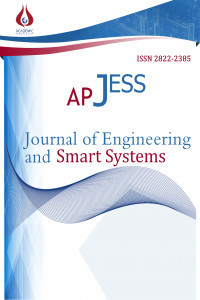Optimization of Cutting Parameters for Sustainable Machining of Titanium Ti-5553 Alloy using Genetic Algorithm
Ti-5333 Alaşımı, Optimizasyon, Genetik Algoritma, İşleme Performansı
Optimization of Cutting Parameters for Sustainable Machining of Titanium Ti-5553 Alloy using Genetic Algorithm
Ti-5553 Alloy, Optimization, Genetic Algorithm, Machining Performance,
___
- Ozkutuk, M. and Y. Kaynak, The effect of material parameters on chip formation in orthogonal cutting simulation of Ti-5553 Alloy. Procedia CIRP, 2017. 58: p. 305-310.
- Hua, K., et al., Characterization of hot deformation microstructure of a near beta titanium alloy Ti-5553. Journal of Alloys and Compounds, 2014. 615: p. 531-537.
- Jayal, A., et al., Sustainable manufacturing: Modeling and optimization challenges at the product, process and system levels. CIRP Journal of Manufacturing Science and Technology, 2010. 2(3): p. 144-152.
- Camposeco-Negrete, C., J.d.D.C. Nájera, and J.C. Miranda-Valenzuela, Optimization of cutting parameters to minimize energy consumption during turning of AISI 1018 steel at constant material removal rate using robust design. The International Journal of Advanced Manufacturing Technology, 2016. 83(5-8): p. 1341-1347.
- Camposeco-Negrete, C., Optimization of cutting parameters using Response Surface Method for minimizing energy consumption and maximizing cutting quality in turning of AISI 6061 T6 aluminum. Journal of cleaner production, 2015. 91: p. 109-117.
- Bhushan, R.K., Optimization of cutting parameters for minimizing power consumption and maximizing tool life during machining of Al alloy SiC particle composites. Journal of Cleaner Production, 2013. 39: p. 242-254.
- Asokan, P., R. Saravanan, and K. Vijayakumar, Machining parameters optimisation for turning cylindrical stock into a continuous finished profile using genetic algorithm (GA) and simulated annealing (SA). The International Journal of Advanced Manufacturing Technology, 2003. 21(1): p. 1-9.
- Mukherjee, I. and P.K. Ray, A review of optimization techniques in metal cutting processes. Computers & Industrial Engineering, 2006. 50(1-2): p. 15-34.
- Coit, D.W. and A.E. Smith, Reliability optimization of series-parallel systems using a genetic algorithm. IEEE Transactions on reliability, 1996. 45(2): p. 254-260.
- Venkatesan, D., K. Kannan, and R. Saravanan, A genetic algorithm-based artificial neural network model for the optimization of machining processes. Neural Computing and Applications, 2009. 18(2): p. 135-140.
- Khan, Z., B. Prasad, and T. Singh, Machining condition optimization by genetic algorithms and simulated annealing. Computers & Operations Research, 1997. 24(7): p. 647-657.
- Yildiz, A.R., Cuckoo search algorithm for the selection of optimal machining parameters in milling operations. The International Journal of Advanced Manufacturing Technology, 2013. 64(1-4): p. 55-61.
- Jawahir, I. and X. Wang, Development of hybrid predictive models and optimization techniques for machining operations. Journal of Materials Processing Technology, 2007. 185(1-3): p. 46-59.
- Deb, K., M. Mohan, and S. Mishra, Evaluating the ε-domination based multi-objective evolutionary algorithm for a quick computation of Pareto-optimal solutions. Evolutionary computation, 2005. 13(4): p. 501-525.
- Kuriakose, S. and M. Shunmugam, Multi-objective optimization of wire-electro discharge machining process by non-dominated sorting genetic algorithm. Journal of materials processing technology, 2005. 170(1-2): p. 133-141.
- Deb, K. and D.K. Saxena, On finding pareto-optimal solutions through dimensionality reduction for certain large-dimensional multi-objective optimization problems. Kangal report, 2005. 2005011.
- Van Veldhuizen, D.A. and G.B. Lamont. Evolutionary computation and convergence to a pareto front. in Late breaking papers at the genetic programming 1998 conference. 1998.
- Marler, R.T. and J.S. Arora, Survey of multi-objective optimization methods for engineering. Structural and multidisciplinary optimization, 2004. 26(6): p. 369-395.
- Konak, A., D.W. Coit, and A.E. Smith, Multi-objective optimization using genetic algorithms: A tutorial. Reliability Engineering & System Safety, 2006. 91(9): p. 992-1007.
- Goel, T., et al., Response surface approximation of Pareto optimal front in multi-objective optimization. Computer methods in applied mechanics and engineering, 2007. 196(4-6): p. 879-893.
- Zwickl, D.J., Genetic algorithm approaches for the phylogenetic analysis of large biological sequence datasets under the maximum likelihood criterion. 2006.
- Poon, P.W. and J.N. Carter, Genetic algorithm crossover operators for ordering applications. Computers & Operations Research, 1995. 22(1): p. 135-147.
- Razali, N.M. and J. Geraghty. Genetic algorithm performance with different selection strategies in solving TSP. in Proceedings of the world congress on engineering. 2011. International Association of Engineers Hong Kong.
- Safe, M., et al. On stopping criteria for genetic algorithms. in Brazilian Symposium on Artificial Intelligence. 2004. Springer.
- Tascioglu, E., A. Gharibi, and Y. Kaynak, High speed machining of near-beta titanium Ti-5553 alloy under various cooling and lubrication conditions. The International Journal of Advanced Manufacturing Technology, 2019. 102(9-12): p. 4257-4271.
- Yayın Aralığı: Yılda 3 Sayı
- Başlangıç: 2022
- Yayıncı: Akademik Perspektif Derneği
Makine Öğrenimi Yöntemleri ile Türkiye için Sera Gazı Emisyonu Tahmini
Melike ŞİŞECİ ÇEŞMELİ, İhsan PENÇE
The influence of particle size on efficiency of quartz flotation
Hüsnügül YILMAZ ATAY, Mustafa ÇIRAK
Fatma DEMİRCAN KESKİN, İnanç KABASAKAL
Ahu ÇELEBİ, Halil TOSUN, Ali Çağlar ÖNÇAĞ
Çok Katlı Betonarme Binalarda 2018 Deprem Yönetmeliği İle Tanımlanan Spektrum Eğrilerinin Etkisi
